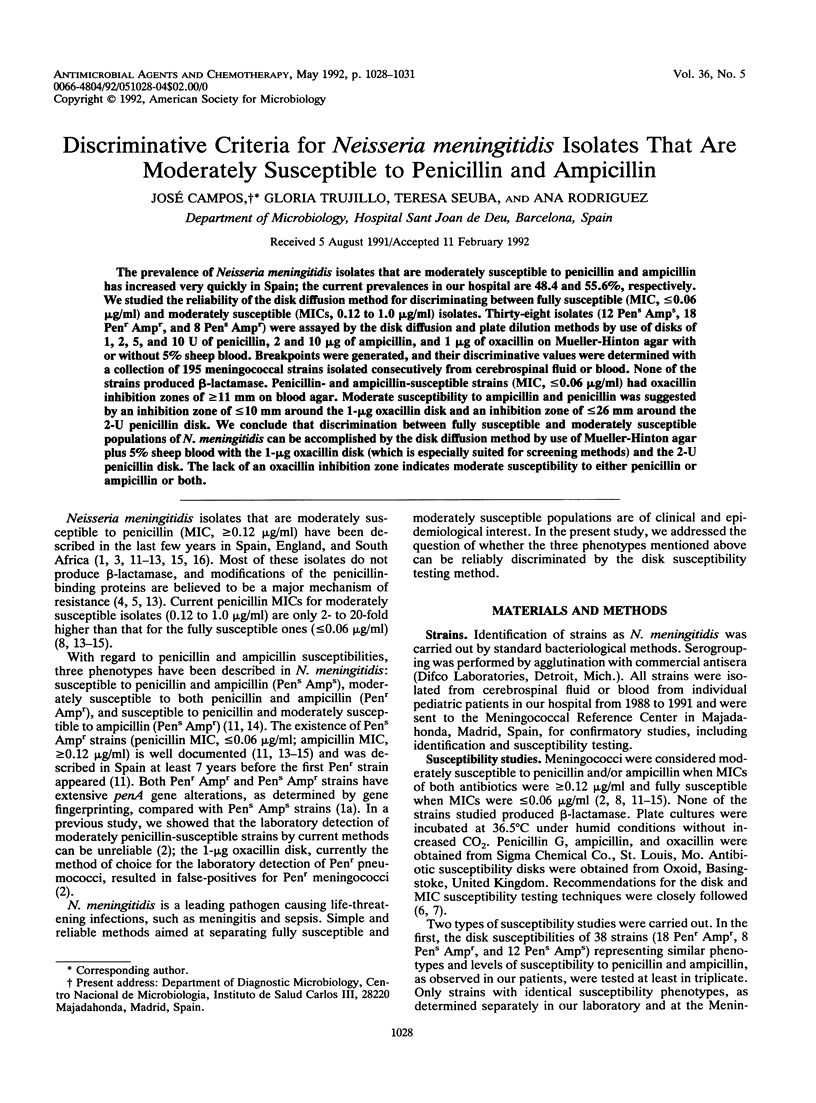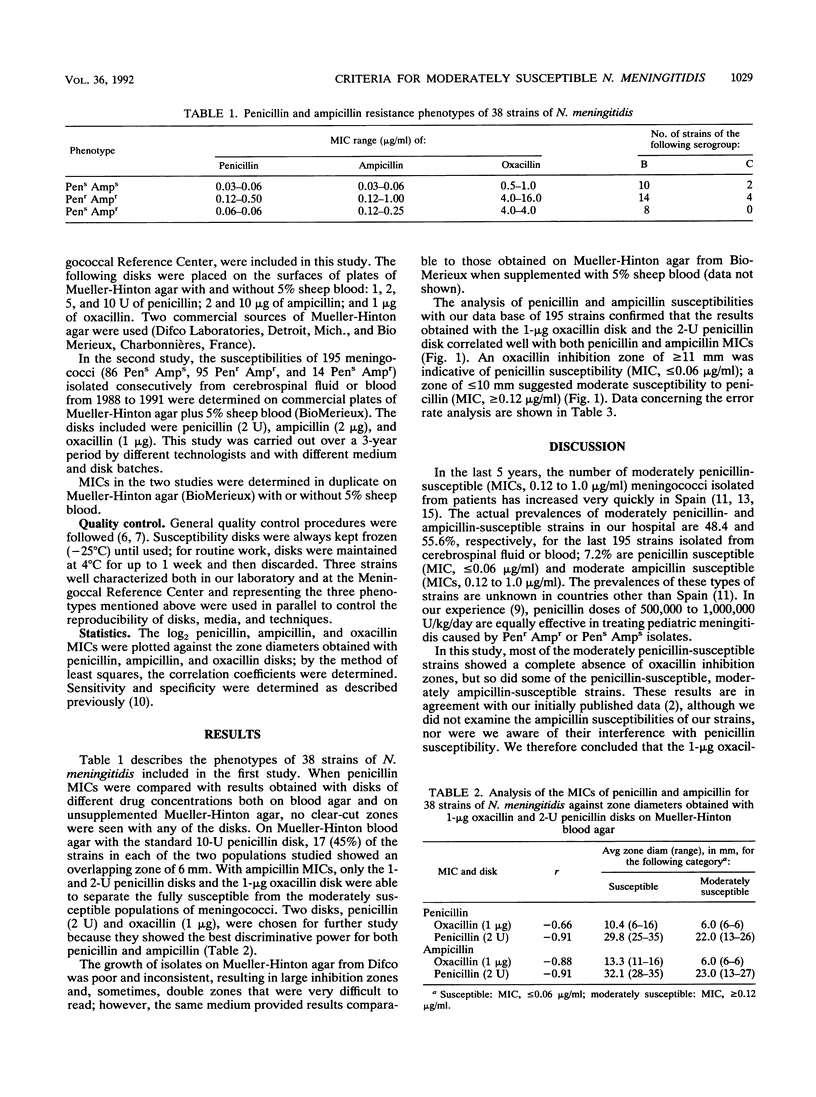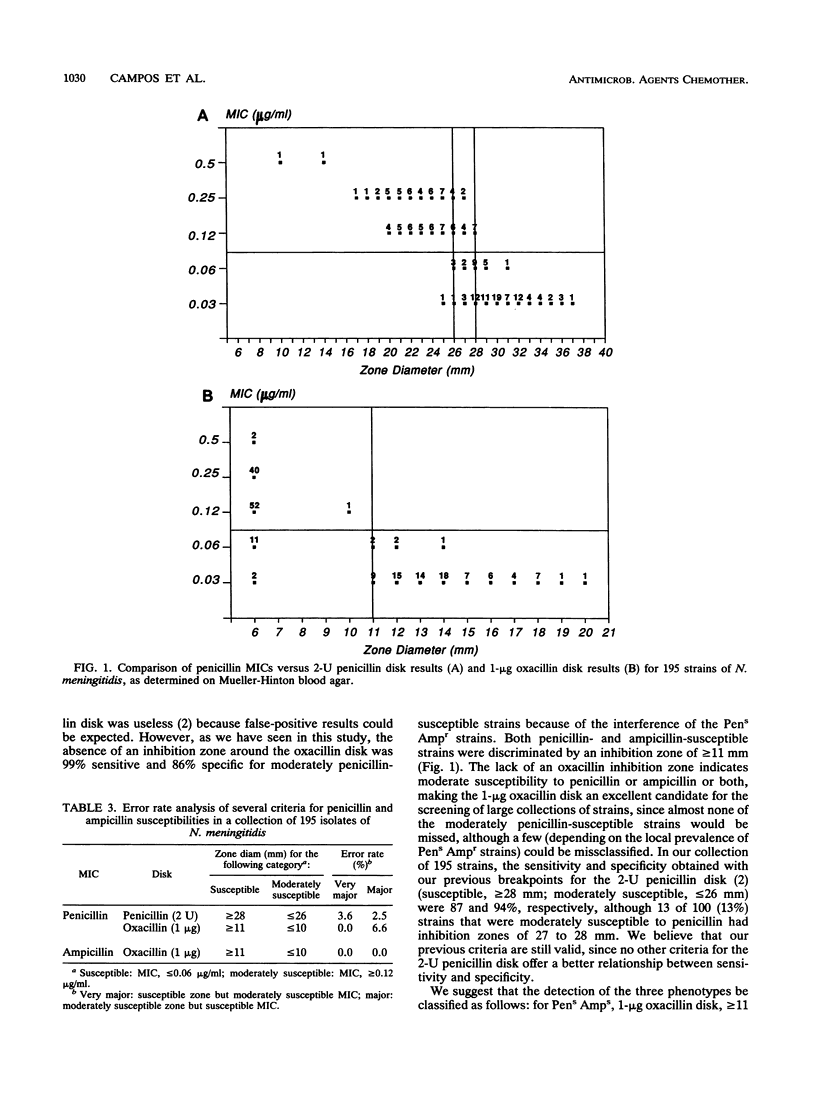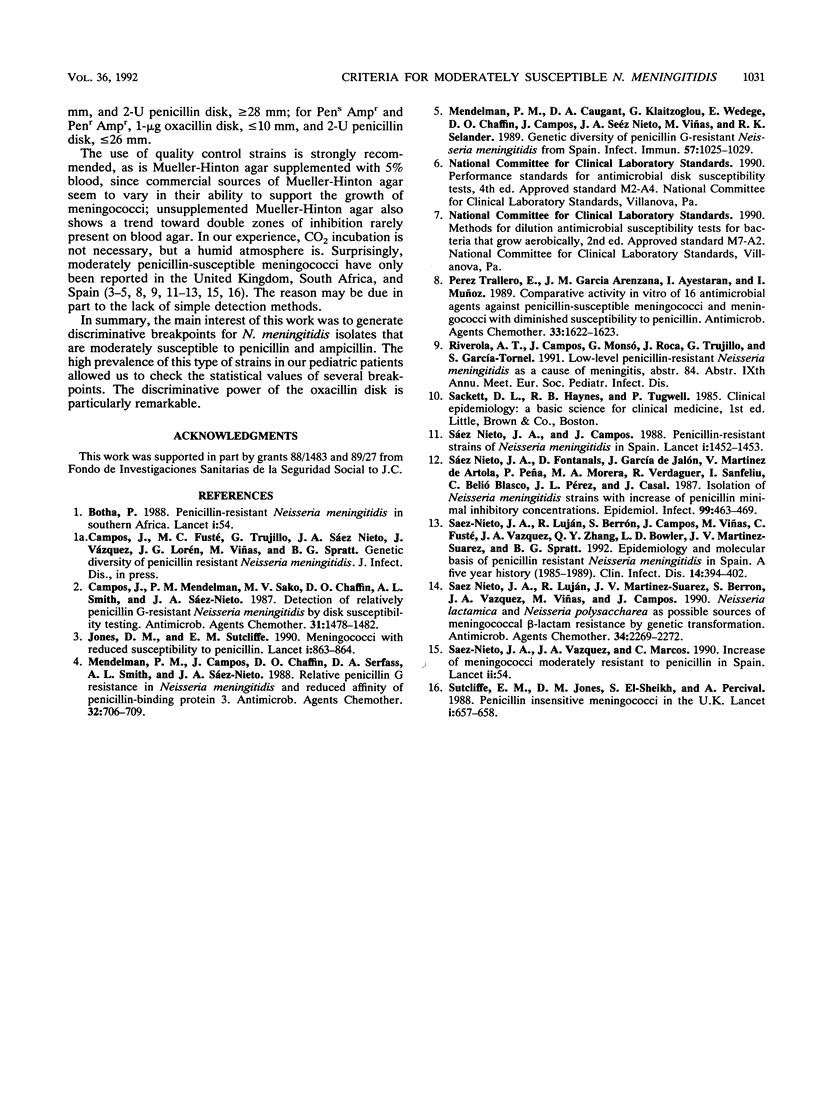Abstract
The prevalence of Neisseria meningitidis isolates that are moderately susceptible to penicillin and ampicillin has increased very quickly in Spain; the current prevalences in our hospital are 48.4 and 55.6%, respectively. We studied the reliability of the disk diffusion method for discriminating between fully susceptible (MIC, less than or equal to 0.06 microgram/ml) and moderately susceptible (MICs, 0.12 to 1.0 microgram/ml) isolates. Thirty-eight isolates (12 Pen(s) Amp(s), 18 Penr Ampr, and 8 Pen(s) Ampr) were assayed by the disk diffusion and plate dilution methods by use of disks of 1, 2, 5, and 10 U of penicillin, 2 and 10 micrograms of ampicillin, and 1 microgram of oxacillin on Mueller-Hinton agar with or without 5% sheep blood. Breakpoints were generated, and their discriminative values were determined with a collection of 195 meningococcal strains isolated consecutively from cerebrospinal fluid or blood. None of the strains produced beta-lactamase. Penicillin- and ampicillin-susceptible strains (MIC, less than or equal to 0.06 microgram/ml) had oxacillin inhibition zones of greater than or equal to 11 mm on blood agar. Moderate susceptibility to ampicillin and penicillin was suggested by an inhibition zone of less than or equal to 10 mm around the 1-microgram disk and an inhibition zone of less than or equal to 26 mm around the 2-U penicillin disk. We conclude that discrimination between fully susceptible and moderately susceptible populations of N. meningitidis can be accomplished by the disk diffusion method by use of Mueller-Hinton agar plus 5% sheep blood with the 1-microgram oxacillin disk (which is especially suited for screening methods) and the 2-U penicillin disk. The lack of an oxacillin inhibition zone indicates moderate susceptibility to either penicillin or ampicillin or both.
Full text
PDF



Selected References
These references are in PubMed. This may not be the complete list of references from this article.
- Botha P. Penicillin-resistant Neisseria meningitidis in southern Africa. Lancet. 1988 Jan 2;1(8575-6):54–54. doi: 10.1016/s0140-6736(88)91029-x. [DOI] [PubMed] [Google Scholar]
- Campos J., Mendelman P. M., Sako M. U., Chaffin D. O., Smith A. L., Sáez-Nieto J. A. Detection of relatively penicillin G-resistant Neisseria meningitidis by disk susceptibility testing. Antimicrob Agents Chemother. 1987 Oct;31(10):1478–1482. doi: 10.1128/aac.31.10.1478. [DOI] [PMC free article] [PubMed] [Google Scholar]
- Jones D. M., Sutcliffe E. M. Meningococci with reduced susceptibility to penicillin. Lancet. 1990 Apr 7;335(8693):863–864. doi: 10.1016/0140-6736(90)90985-e. [DOI] [PubMed] [Google Scholar]
- Mendelman P. M., Campos J., Chaffin D. O., Serfass D. A., Smith A. L., Sáez-Nieto J. A. Relative penicillin G resistance in Neisseria meningitidis and reduced affinity of penicillin-binding protein 3. Antimicrob Agents Chemother. 1988 May;32(5):706–709. doi: 10.1128/aac.32.5.706. [DOI] [PMC free article] [PubMed] [Google Scholar]
- Mendelman P. M., Caugant D. A., Kalaitzoglou G., Wedege E., Chaffin D. O., Campos J., Saez-Nieto J. A., Viñas M., Selander R. K. Genetic diversity of penicillin G-resistant Neisseria meningitidis from Spain. Infect Immun. 1989 Apr;57(4):1025–1029. doi: 10.1128/iai.57.4.1025-1029.1989. [DOI] [PMC free article] [PubMed] [Google Scholar]
- Pérez Trallero E., Garcia Arenzana J. M., Ayestaran I., Muñoz Baroja I. Comparative activity in vitro of 16 antimicrobial agents against penicillin-susceptible meningococci and meningococci with diminished susceptibility to penicillin. Antimicrob Agents Chemother. 1989 Sep;33(9):1622–1623. doi: 10.1128/aac.33.9.1622. [DOI] [PMC free article] [PubMed] [Google Scholar]
- Saez Nieto J. A., Vazquez J. A., Marcos C. Meningococci moderately resistant to penicillin. Lancet. 1990 Jul 7;336(8706):54–54. doi: 10.1016/0140-6736(90)91567-t. [DOI] [PubMed] [Google Scholar]
- Saez-Nieto J. A., Lujan R., Martinez-Suarez J. V., Berron S., Vazquez J. A., Viñas M., Campos J. Neisseria lactamica and Neisseria polysaccharea as possible sources of meningococcal beta-lactam resistance by genetic transformation. Antimicrob Agents Chemother. 1990 Nov;34(11):2269–2272. doi: 10.1128/aac.34.11.2269. [DOI] [PMC free article] [PubMed] [Google Scholar]
- Sutcliffe E. M., Jones D. M., el-Sheikh S., Percival A. Penicillin-insensitive meningococci in the UK. Lancet. 1988 Mar 19;1(8586):657–658. doi: 10.1016/s0140-6736(88)91469-9. [DOI] [PubMed] [Google Scholar]
- Sáez-Nieto J. A., Fontanals D., Garcia de Jalon J., Martinez de Artola V., Peña P., Morera M. A., Verdaguer R., Sanfeliu I., Belio-Blasco C., Perez-Saenz J. L. Isolation of Neisseria meningitidis strains with increase of penicillin minimal inhibitory concentrations. Epidemiol Infect. 1987 Oct;99(2):463–469. doi: 10.1017/s0950268800067960. [DOI] [PMC free article] [PubMed] [Google Scholar]
- Sáez-Nieto J. A., Lujan R., Berrón S., Campos J., Viñas M., Fusté C., Vazquez J. A., Zhang Q. Y., Bowler L. D., Martinez-Suarez J. V. Epidemiology and molecular basis of penicillin-resistant Neisseria meningitidis in Spain: a 5-year history (1985-1989). Clin Infect Dis. 1992 Feb;14(2):394–402. doi: 10.1093/clinids/14.2.394. [DOI] [PubMed] [Google Scholar]


